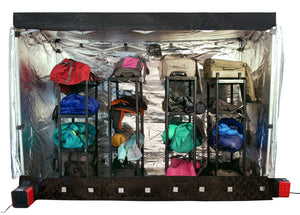ZappBug Chambers Help Shelters Respond to Growing Need
“The ZappBug Ovens are extremely helpful to our work. The fact that there are multiple sizes of the ZappBug Ovens are also helpful, because we don’t have the ability to use the larger versions at every site. By utilizing the Heat Chambers and regular cleaning, combined with hard standards of care and neatness, we have been so far able to combat pest control issues at all our sites without any large-scale infestations.”
Bed bugs, German roaches, fleas, and other pests are increasingly difficult to control with traditional insecticides. In particular, bed bugs continue to interrupt the operation of businesses and nonprofits. Because ZappBug chambers use heat to eliminate bed bugs and other pests, we often work with interesting customers who have challenging pest control problems. It’s a privilege to help these organizations, doubly so when we get to share their stories.
Customer type: Nonprofit, Homeless shelter
Pest type: Bed bugs and others
The problem: While controlling bed bugs and other pests can be challenging in many environments. Nonprofits that seek to address homelessness or offer services to unhoused persons face a constant threat of pest introduction. Any person or their belongings may harbor pests. Additionally, the concentration of beds and people within these facilities allows infestations to spread rapidly within these facilities. Finally, many nonprofits work to stretch limited resources in order to do the most good for the most people. Unexpected pest control expenses make this job even more challenging.
The customer: Andrew is an administrator at a West Coast nonprofit specializing in services for homeless people. They have multiple locations and offer assistance to individuals and families with chronic physical and psychological disabilities, substance use disorders, and other challenges. Below are excerpts from our conversation with Andrew.
1. What kind of pests prompt you to use your heat chamber?
- We will use the Heat Chamber following the report of ANY pest, whether it be bed bugs, roaches, lice, or anything else.
2. When do you heat a resident’s belongings? Are every client’s belongings heated, or just when staff detects or suspects an issue?
- Our shelters all practice an “At first Entry” policy, where all guests’ belongings are either laundered or heat-treated. The guests must also shower at the same time, and then simple clothes are given to them while their regular clothes are being treated. Following the first entry, we also use the Heat Chambers any time staff suspects an issue.
3. How often would you say you use the heat chamber?
- In a typical day, we probably use the heat chamber for about twice a day, per shelter
Q. What other products or measures do you take to control pests in your facilities? (mattress encasements, glue traps, etc.)
All our beds are solid metal frames with bug-proof mattresses (heat-sealed, non-seamed, anti-microbial and liquid-proof mattresses with steel mesh ventilation). We also use regular spray pesticides for on-site extermination, and regular bed-checks and bed-cleanliness standards.
Q. How effective would you say you are in controlling or containing pest control issues? How helpful is the heat chamber in this effort?
The ZappBug Ovens are extremely helpful to our work. The fact that there are multiple sizes of the ZappBug Ovens are also helpful, because we don’t have the ability to use the larger versions at every site. By utilizing the Heat Chambers and regular cleaning, combined with hard standards of care and neatness, we have been so far able to combat pest control issues at all our sites without any large-scale infestations. We also have internal Pest Control protocols which include a point at which outside pest control professionals would be called in the event we were not able to get ahead of the situation.
Takeaways: There are a few things about Andrew’s response that I’d like to highlight.
- They have multiple layers of intervention. Controlling pests in this environment requires the cooperation of staff, clients/residents, and a professional pest management company. Staff utilize ZappBug heat chambers and laundry facilities at the point of first entry. Additionally, they utilize furniture that makes detecting and preventing pest infestations easier. They also have detailed cleaning standards. Finally, they leave the chemical aspect of treatment to pest management professionals.
- They have a comprehensive “first entry” policy towards treatings a client’s belongings. Andrew says they even provide clients with clothing after they shower so that the clothes they wear in the door can also be heated. You would not wash your hands halfway through a meal. Similarly, if you are only laundering a portion of the belongings your clients bring with them, or you start this process late in the orientation cycle, the client may have already introduced pests into your facility.
- The goal is to prevent infestations. Pests will make their way into your facility even under ideal conditions. The key is to create practices and processes that reduce the frequency of these introductions, and also to create an environment that facilitates early detection and a quick response from staff.
Conclusion: Shelters and nonprofits that offer services to homeless individuals face unique challenges that require proactive pest management practices. Utilizing integrated pest management techniques and gaining the cooperation of clients and staff are critical.


